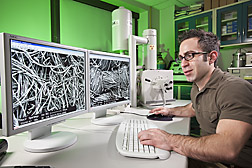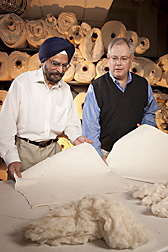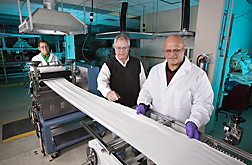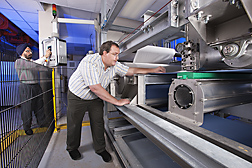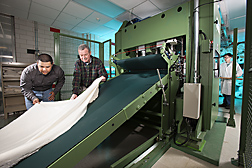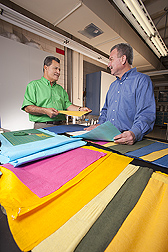Cotton’s Potential for Padding Nonwovens
About 98 percent of cotton produced worldwide today is used in woven and knitted fabrics and a variety of threads, ropes, and cables. These materials are known as “traditional textiles.” A wide variety of machinery, chemicals, and manufacturing processes are involved in producing these textiles. For example, carding machines, which are outfitted with fine wires of different shapes, separate and coax cotton fibers into alignment. The aligned fibers then are formed into a long braidlike material called “sliver,” which becomes the basic material for spinning yarns. These yarns are used mostly to weave or knit fabrics and to ply into sewing threads.
Innovations in textile technologies continue to automate and integrate manufacturing processes to increase fabric productivity and quality. During the last century, a new generation of textile equipment began making fabrics—known as “nonwovens”—in a continuous sheet form and at a very high production rate compared to that of woven fabrics.
New Uses for Cotton Fibers
Nonwoven fabrics, made from natural or synthetic fibers, are made without spinning or weaving yarns. Instead, these flat, porous sheets of fabric are mostly made by entangling or bonding the fibers. “The process of entangling fibers gives nonwoven fabrics strength,” says Brian Condon, research leader with the Agricultural Research Service’s Cotton Chemistry and Utilization Research Unit, in New Orleans, Louisiana. The unit is part of the ARS Southern Regional Research Center (SRRC).
At first, nonwoven fabrics were made using synthetic polymer-type fibers, such as polyester, polypropylene, and polyethylene, and some regenerated fibers, such as rayon, which is plant based. But in recent years, some nonwovens manufacturers have begun adding cotton to nonwovens used in absorbent hygiene products and personal-care wipes.
In 1968, a U.S. trade association was formed called “The Disposables Association.” Recognizing that nonwoven fabrics were being used in an increasingly wider variety of end products, the organization changed its name in 1972 to the International Nonwovens and Disposables Association (INDA). The U.S. nonwoven fabrics industry now includes machinery producers, roll-goods producers, and raw-materials suppliers and converters. In 1976, INDA changed its name yet again to the Association of the Nonwoven Fabrics Industry, although the INDA acronym remains.
Ian Butler, INDA’s director of market research, predicts rapid growth in some segments of nonwovens in both household and institutional markets. During the past few decades, the nonwovens markets in the United States, Europe, and Japan expanded greatly, mainly because of considerable advances in equipment, processing technologies, and product developments, according to Butler.
“The industry is now growing in most regions around the world. Total worldwide growth of this industry is about 7 to 8 percent per year,” says Butler. “The wipes industry segment in particular is undergoing tremendous growth.”
From Hygiene to Auto Products
The disposable nonwovens markets include several different product categories, including absorbent hygiene products (baby diapers, feminine sanitary napkins, tampons, pantiliners, adult incontinence products, and underpads) and wipes for baby, personal, household, and medical care.
“We are astounded at the phenomenal growth of the general wipes industry, with some markets growing in the double-digit range per year,” says Butler. “In the late 1990s, retail sales of all wipes in the United States and Canada combined was about $700 million; but within 5 years—by 2005—those sales jumped to $2 billion.”
The nursing-facility industry, for example, is using adult diapers and bathing wipes made of nonwovens. At SRRC, projects are in the works to produce disposable bedsheets that would be particularly attractive to hospitals and nursing facilities.
Cotton, a premium fiber, enjoys the greatest market share of all natural fibers sold worldwide today, according to Janet O’Regan, director of strategic initiatives with Cary, North Carolina-based Cotton Incorporated.
While the use of cotton in nonwovens consists of less than 2 percent of all fibers currently used in nonwovens worldwide, some U.S. commercial products, like cosmetic pads and facial wipes, contain 100 percent cotton, according to experts.
“Since cotton is a significant crop internationally, we want to aggressively promote value-added utilization of cotton—particularly in the rapidly growing nonwovens industry,” says Condon. “Cotton fibers can be added to nonwoven fabrics to produce products that are economical, functionally efficient, eco-friendly, and sustainable.”
Materials engineer Dharnidhar Parikh, also at the ARS cotton utilization unit in New Orleans, reported that nonwovens made from blends of plant-based fibers—cotton, kenaf, jute, and flax—and polypropylene could be used in automobiles to insulate passengers from engine and outside noise. One study showed that each of the above-mentioned cellulose-based nonwovens had sound-absorbing properties comparable to those of the materials actually used in auto interiors.
Parikh also reported that the nonwovens made from blends containing biodegradable natural fibers could be made lighter in weight than their all-synthetic counterparts. “These blends have the potential to lower operating costs, because making lighter weight cars leads to better gas mileage,” says Parikh. The 2007 study was published in Textile Research Journal.
Mattresses and other bedding products are required to be made with flame-retardant materials. One reason is that nonwoven materials are fluffy, so they burn more readily. It has been shown that suitable mattress and bedding nonwoven materials can be made from raw, virgin lint, which is ginned cotton that has not been bleached. Virgin cotton is referred to by industry as “greige” (pronounced “gray”) cotton.
“Virgin cotton is much less expensive than bleached cotton or some synthetics,” says Condon. ARS studies are now under way to determine the flame-retardant properties of such materials and to improve those properties. “We are working on several specific approaches to improving flame-retardant performance, and so far, we’ve seen several good successes in the lab,” he says.
Triumph Over Adversity
Use of cotton fibers in the nonwovens sector has been limited partly by the production costs of bleaching cotton. “We wanted to explore new research avenues to increase the use of cotton in nonwovens,” says Condon.
Then, a crisis occurred that accelerated change.
In 2005, Hurricane Katrina shut down the SRRC. “We used that disaster as a turning point to change direction and emphasize use of cotton in nonwovens as our new area of cotton research,” says Condon. “We purchased a new fleet of state-of-the-art nonwoven machinery and equipment for conducting basic and applied research to develop new technologies to incorporate cotton into existing and new products.” In 2007, SRRC opened its Cotton Nonwovens Research Laboratory and Pilot Facility.
The machinery includes three lines of nonwovens research equipment totaling 16 machines. The needle-punch line is made by TechnoPlants; the hydroentanglement line is made by Fleissner; and the finishing line is made by Mathis.
Hydroentanglement, sometimes called “spunlacing,” is a process in which closely spaced, high-pressure water jets strike a web or batt of loosely held fibers supported on a screenlike moving belt made of polyester woven fabric. The jet-impacted fibers are then rearranged and entangled to form a strong sheet of woven-like fabric. This hydroentangling technique is a leading technology, especially within the cotton and staple-fiber nonwovens sector, and is sometimes combined with needle-punching.
Several test instruments were purchased to assess the products of the research efforts. Condon also had existing cotton carding equipment modified to produce a web of cotton fibers instead of sliver. The result of this lab-equipment revolution is the ARS-SRRC Cotton Nonwovens Research Center. The expanded research effort now involves efficient use of the new fleet of sophisticated equipment, more emphasis on processing nonwoven fabrics, and more outreach to a variety of potential markets.
|
|
Nonbleached Cotton’s Debut
“Most of the cotton fiber used in the nonwovens sector up until now has been bleached cotton,” says Butler. “But bleached cotton is relatively expensive and complex to process, so there is considerable effort to develop a wipe using nonbleached cotton.”
ARS cotton technologist Paul Sawhney, the lead scientist of the cotton-based nonwovens research program at the center, and colleagues conducted preliminary studies to investigate the use of virgin cotton in nonwovens. The studies showed that ginned virgin cotton could be processed directly on existing cotton carding equipment. “Cotton’s natural waxes actually provide a measure of lubrication that considerably helps in carding the fibers,” says Condon. “Bleached cotton fibers create tough problems in the carding process.”
“We then efficiently processed the virgin cotton on the center’s modern nonwoven fabrics production equipment,” says Sawhney. “We were pleased with the quality of the first experimental 100-percent virgin cotton nonwoven fabrics that we produced.” Sawhney reported some of those findings in the proceedings of the 2009 International Cotton Conference, held in Bremen, Germany.
“We have produced several lightly pre-needled condensed webs of virgin cotton on commercial-grade needle-punch equipment to investigate the hydroentanglement process of fabricating nonwovens,” says Sawhney. “We have evaluated the processing of virgin cotton on a TechnoPlants needle-punch machine and on a Fleissner hydroentanglement system and the properties and characteristics of the nonwoven fabrics produced.” The team found that greige cotton, which is naturally water repellent, can be made absorbent mainly by controlling the hydroentanglement water pressure.
Various forms of cotton include byproducts, such as discounted cottons, ginning waste (motes and linters), and textile processing wastes (card strips, comber noils). Sawhney believes that these forms of cotton could be suitable for use in nonwovens such as wipes, upholstery, and quilt-blanket inserts.
The researchers published these findings in a 2010 study, “Advent of Greige Cotton Nonwovens Made Using a Hydro-Entanglement Process” in Textile Research Journal.
|
|
No Bleach, No Debris
About 25 years ago, Tom Gary, owner of Greenwood, Mississippi-based Wildwood Gin, Inc., began specializing in cleaning gin waste, or linter, and providing that fiber to paper mills and traditional textile mills. But in the last decade, Gary’s team, which includes son Lawson Gary, began purchasing and drastically modifying textile equipment to create an entirely new plant and textile process.
“The new process removes trash from regular cotton fibers at unprecedented levels,” says Lawson Gary. Trash includes leaves, sticks, burs, bark, and other debris in ginned cotton.
“In the past 2 years, we have been working with scientists at the SRRC Cotton Nonwovens Research Center to produce and evaluate fabrics made with our ready-to-use, clean, natural-cotton fibers,” says Gary. “We provide high-quality reprocessed cotton fibers that are cleaned with no chemical bleaching, water, or process heat.” According to Gary, these fibers have been very well received by hydroentanglement and needle-punch nonwovens manufacturers in the United States and western Europe.
“Working with the SRRC scientists has allowed us to test our fibers’ performance in a number of 100-percent cotton nonwoven materials,” says Gary. The result is that Wildwood Gin has begun marketing mechanically cleaned, natural cotton to manufacturers of personal care products within the nonwovens industry.
“An international brand is making plans to roll out a number of personal-care nonwoven products that include our fibers,” says Gary. “The SRRC researchers have made first-of-a-kind samples and modeled production runs of 100-percent cotton nonwoven fabrics in their pilot facility. Those cotton-containing test fabrics helped us with proof-of-concept and enabled real-time use of these fibers in personal-care products.”
“The ability to put precleaned, nonbleached greige cotton directly into nonwoven fabrics could be considered an industry breakthrough,” says O’Regan.
In a new study, SRRC scientists have compared two forms of cotton: One was ginned and conventionally cleaned, and the other was cleaned with Wildwood Gin’s new mechanical-cleaning process.
The study showed that nonwoven textile plants, with certain nominal modifications, could use the mechanically cleaned, natural cotton without adding new equipment. This comparison study was published in 2011 in Textile Research Journal.
According to Sawhney, mechanically precleaned, nonbleached greige cotton is a good candidate for use in newer and improved nonwoven materials and end-use products, such as disposable, reusable, recyclable, washable, and perhaps even flushable wipes. Other products could be institutional uniforms, toweling, sheeting, furnishings, tablecloths and mats, napkins, undergarments, pajamas, and even sustainable “green” denims.
“Elimination of the scouring process in cotton-based nonwovens is a major milestone in the value-added utilization of greige cotton in nonwovens,” says Sawhney.
“The SRRC researchers are helping industry understand how to process virgin cotton and use it directly in nonwoven fabrics without bleaching,” says O’Regan.
New Nonwoven Products
SRRC’s textile technologist Michael Reynolds says that in 2010, several nonwovens roll-goods manufacturers and retailers expressed interest in the development of cotton-containing nonwoven products, especially wipes.
“We have a trust agreement with one group to develop cotton-based nonwoven products for the home sewing, crafting, and quilting markets,” says Reynolds. “Another group gave us specifications to develop a very-heavy-weight, needle-punched, 100-percent cotton nonwoven material.” SRRC provided a piece of the required material, and the cooperator is evaluating the sample for potential commercial application.
“We anticipate that cotton can be useful in many other end-use applications of existing nonwoven products,” says Reynolds.—By Rosalie Marion Bliss, Agricultural Research Service Information Staff.
This research is part of Quality and Utilization of Agricultural Products, an ARS national program (#306) described at www.nps.ars.usda.gov.
Brian Condon is at the USDA-ARS Southern Regional Research Center, 1100 Robert E. Lee Blvd., New Orleans, LA 70124; (504) 286-4540.
"Cotton’s Potential for Padding Nonwovens" was published in the September 2011 issue of Agricultural Research magazine.







